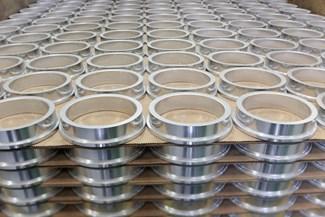 Soft Magnetic Composites (SMC) is a breakthrough technology with massive potential to shape the future of electrified applications. SMC have unique features that allow for a non-magnetic material to become magnetic in application use. Adding an electric current to a carefully designed component made with SMC, an electro-magnetic field is created. SMCs are used in the powder metal process as a lower cost replacement to stacked laminations in BLDC E-Motors. The motor designer can utilize this technology to design a smaller thus lower cost alternatives to traditional laminated technology. With mounting pressures for higher efficiencies, smaller components, and sustainable materials; SMC components lead the way.
Soft Magnetic Composites (SMC) is a breakthrough technology with massive potential to shape the future of electrified applications. SMC have unique features that allow for a non-magnetic material to become magnetic in application use. Adding an electric current to a carefully designed component made with SMC, an electro-magnetic field is created. SMCs are used in the powder metal process as a lower cost replacement to stacked laminations in BLDC E-Motors. The motor designer can utilize this technology to design a smaller thus lower cost alternatives to traditional laminated technology. With mounting pressures for higher efficiencies, smaller components, and sustainable materials; SMC components lead the way.
Soft Magnetic Composites are created by coating each individual particle of iron with an insulation material. By providing an insulation prior to compacting the part, the result is a component with high-resistivity and very little eddy current losses. Coupling the material capabilities with the design freedom of conventional powder metallurgy, components can be designed to guide the magnetic flux taking advantage of 3D vertical architecture such as axial, transverse, and radial flux motors operating at 400Hz to 2000 Hz.
What Are The Advantages of these Soft Magnetic Composite Materials?
When an application is designed with SMC the advantages quickly compound. Most notably, design complexity and freedom that is achieved through using the powder metallurgy process with an SMC material. As PM is a naturally green technology, there is the reduction in overall manufacturing costs and time. Complex geometries that direct magnetic flux allow for application designers to reduce the size, weight, and waste of the end product.
Utilizing PM SMC eliminates the need for the expensive lamination process and limited material availability of NOES steel, while providing superior magnetic flux properties compared to the 2D competitor. With less processing and a smaller component design, integration not only becomes possible but more so becomes the next logical step. For example; an electric motor that was previously purchased separately and attached to an application, could now be designed as an integrated motor with modular assembly directly into the final product.
Components are made in tooling with a single pressing followed by a low temperature thermal operation and are ready for assembly immediately following. SMC components have 3D flux paths allowing the motor designer to take advantage of extended back irons and tooth tips facilitating optimal utilization of copper and magnet materials reducing flux leakage and tooth tip saturation effects.
The 3D geometry can also facilitate pre-wound copper facilitating modular assembly. The PM process is ideal for Axial Flux and Radial Flux Stator manufacture.
Another advantage of SMC materials is the very high electrical resistivity, making it a beneficial material for axial flux motors where magnetic fringing flux can create significant eddy current losses in laminations.
Soft Magnetic materials are at the center of the efficient running of next-gen electric motors and Drives. SMCs can deliver the following results:
- Enhanced assembly capabilities.
- Reduction in the size and weight of components.
- Increased performance levels from high saturation of magnetic flux density.
- Cost-efficient design and production methods requiring less material and less secondary operations.
- Lower core and eddy current losses
Industry Applications For SMCs
New developments in powder metallurgy make SMC materials interesting for electrified applications when combined with cutting edge designs and new production techniques. This is particularly beneficial to the automotive industry that’s currently at an inflection point in finding cost-efficient traction motors. Soft Magnetic Materials (SMCs) will allow the transition to electric vehicles to happen at a faster rate. Not only does it reduce the need for fossil fuels, but it also eliminates the use of Rare Earth Magnets and Rare Earth Materials used in traditional motors.
The SMC technology also has useful applications in industrial markets. Some of the uses in Industrial applications include solar power, off-board power generation, motors, and drives. SMCs are also advantageous in other automotive applications, including traction motors, E-pumps, direct current conductors, and compressors.
Soft magnetic composite materials make it possible to design innovative, compact, and powerful electric motors that match your specific application. Some examples of these applications are:
- Traction motors
- Axial Flux motors
- Radial Flux motors
- Linear Motors
- Solenoids and Actuators
- Pumps
- Fans
- Compressors
- Valve Controls
- Generators
Why Select MPP as Your SMC Partner
At MPP, we engineer the future. Thanks to our innovative capabilities relating to axial flux technology, we’re helping to speed the transition to electric vehicles, reduce the need for fossil fuels, and eliminate the need for rare earth magnets and materials.
MPP’s technology allows for the opportunity to efficiently manufacture E-motors with no rare Earth magnets. Leveraging our capabilities with the use of magnetic flux technology, allows SMCs to increase motor efficiency and reduce overall costs.
MPP’s engineers are always working to develop new materials, applications and manufacturing techniques that drive innovation. Our goal is to provide cutting edge solutions for technology that will change the world.
With dwindling supply chains of rare earth materials, NOES, and rising processing costs. MPP and our partners can provide solutions for electrification far superior to competitive processes. Contact MPP us now Solutions@mppinnovation.com.
Check out how MPP’s SMC capabilities combine with one of our key client’s designs to create an electric motor with no rare earth materials!
